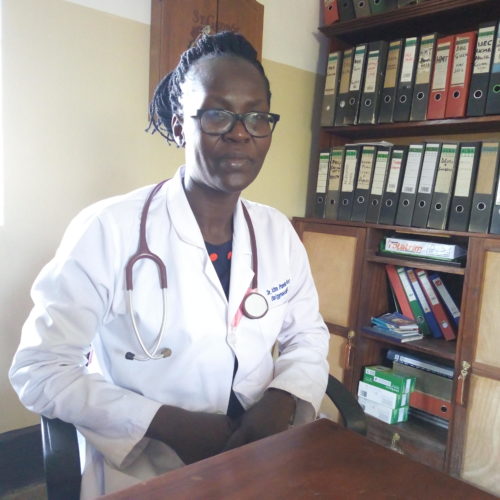Through bold vision and tireless advocacy, Dr. Atim Pamela has transformed healthcare at SJHK — establishing a training school, constructing a modern theatre and eye complex, and introducing vital services like dental, physiotherapy, and private wards. Her leadership continues to uplift healthcare for communities across Northern Uganda.
History of SJHK
St Joseph’s Hospital Kitgum is located in Kitgum Municipality about 3 kms from the Kitgum town center. It is a private not for profit public hospital under Gulu Archdiocese and belongs to the Network of Uganda Catholic Health facilities.
The current hospital capacity is 280 beds. The hospital was established 1960 with 100 beds.
The present hospital started as a clinic (Aid Post) under the veranda of the Comboni Sisters in 1925. Later in 1938 a dispensary was opened under a Mango tree in the convent of the Comboni Missionaries (sisters). The dispensary, under the mango tree provided OPD services for minor ailments and was run by Comboni Sister.
Second World War interrupted services..
and the dispensary temporarily closed.
After the world war the Verona Fathers and Sisters consulted the local community occupying the present land the hospital is located to provide the land for development. The community willingly accepted and evacuated the place. To evacuate or move aside means “Nyiki” in luo.
In 1952 a block was constructed and the dispensary was upgraded to a health center that provided maternity and OPD services.
Two years later, 1955 the Provincial Medical Officer Gulu visited the facility and noted the very good work being done and encourage collaboration with the government hospital to improve and provide services.
Funds for additional new construction came through the Comboni Missionaries who also managed the hospital on behalf of the Bishop of Gulu Diocese.
There was rapid infrastructure development in the health center and in January 1960 the Ministry of Health upgraded the health center into hospital with 100 beds. Since that time the hospital grew to a bed capacity of 350 beds because of demand during the peak of insurgency in Kitgum, however with the return of peace the capacity has been downsized to 280 beds.
The comboni Sisters left active management of the hospital in 1971. Since then the hospital is managed by, Board of Governors led by the Archbishop of Gulu and the Little Sisters of Mary Immaculate of Gulu provide a fundamental input in the management of the hospital.

In 2003, Dr. Lawrence Ojom assumed office as the Medical Superintendent at a time when the Northern Uganda insurgency was at its climax. During this period, the nearby communities took refuge at the hospital, mostly at night. It was a very difficult time for the hospital due to poor sanitation caused by the large number of people seeking refuge there.
In 2004, Dr. Lawrence welcomed an Italian doctor, Dr. Salandini Giorgio, and his wife, Maria Carla Ossola, who started a library at the hospital to support patients and night commuters with reading materials. At that time, the library became a department within the hospital, equipped with various types of books for medical practitioners, university students, and primary school pupils.

Dr. Theresa Pellio served as the Medical Superintendent of St. Joseph’s Hospital Kitgum from 1996 to 2002, a period marked by significant improvements in the hospital’s administrative and human resource management systems.
During her leadership, Dr. Pellio established the offices of Administrator and Personnel, enhancing the hospital’s capacity to efficiently manage staff welfare, finances, and operational resources. This was a strategic shift from the previously centralized management structure and paved the way for more organized and accountable hospital administration.
The Office of the Administrator was formally created in 1997 and first occupied by Sr. Jeman Dhugira. She was later succeeded by Mr. T.P. Odong, Mr. Oloya Alex, Mr. Ochola Robert, and Rev. Fr. Obina Wilfred, who is currently serving in the position.
The establishment of this office streamlined the management of material resources, finances, and human resource affairs, addressing operational challenges that had existed in previous years and laying a foundation for better hospital governance.

The tenure of Dr. Adolf Diefanhardt, who served as Medical Superintendent from 1990 to 1995, recorded significant milestones in the development of St. Joseph’s Hospital Kitgum. His leadership period registered remarkable progress in both infrastructure expansion and service delivery.
Among his notable contributions was the extension of the existing administration block and medical ward, previously known as A'Clinic. He also oversaw the construction of several vital hospital facilities including the doctor’s quarters, the hospital chapel, the Nutrition Unit—commonly referred to as “Kampala” by the local community—the Technical Department, Counseling Centre, and Care Made Unit.
In addition, Dr. Diefanhardt introduced mobile clinic services, which greatly improved access to healthcare services within the community, especially in remote areas[..]

During one of Uganda’s most difficult periods, Dr. Fillippo Ciantia kept St. Joseph’s Hospital Kitgum operational through the 1986 conflict. His leadership saw the construction of new staff quarters, laboratory upgrades, and vital support from the Italian government. Together with his wife Dr. Luciana and Dr. Angelo Manini, their unwavering service left a lasting mark on healthcare in Northern Uganda.

On 27th September 1971, Dr. Rev. Fr. Albert Manuel Grau, a Comboni Missionary from Spain, officially became the first Medical Superintendent of St. Joseph’s Hospital Kitgum. Born in Spain on 28th July 1938, he passed away in Gulu, Uganda on 21st February 1999, and was laid to rest in Kitgum, the community he faithfully served.
A man of great compassion and dedication, Fr. Grau worked tirelessly to uplift the hospital’s standards and services. As both a qualified surgeon and administrator, he personally oversaw the construction of the hospital’s first theatre building, which significantly improved surgical care in the region.
During his tenure, the hospital depended entirely on the Catholic mission for financial support, medical supplies, and personnel, reflecting the deeply rooted missionary spirit of service.
Fr. Grau was supported in his work by a dedicated team of medical professionals, including Dr. Enrico Guffanti, Dr. Todeshi, Dr. Sbrighi, and Dr. Chiara Messalira, all of whom contributed to the early growth and stability of the hospital.
His legacy as a pioneer of compassionate, faith-based healthcare at St. Joseph’s Hospital Kitgum remains a cherished chapter in the hospital’s history


